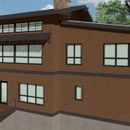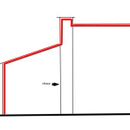Detailing a chimney
I know, I know—if I really wanted to be efficient, I would eliminate the chimney. However, I love a good fire and the warmth from it. So, my new house will have a zero-clearance wood-burning unit (RSF 320).
The chase for the chimney is mostly inside the envelope, except for a portion at the top. I have attached the rendering to show what it looks like from outside.
I am wondering how exactly to air seal and insulate this in an ideal manner. I have attached another simple diagram trying to delineate the air seal. This house will have a spray-foamed, unvented attic space. Is it feasible to seal this chase up? Should I insulate only that upper area that is partially outside the envelope or insulate the whole chase?
That is a great room to the left, with a 17′ tall ceiling — so I don’t think i need any fire stopping midway up the chase, but could add it if it would help seal it up. The plans are rather vague on the details here so I would like to be ready when the hammers start flying (or nail guns, as the case may be).
GBA Detail Library
A collection of one thousand construction details organized by climate and house part











Replies
Kevin,
Is the chimney masonry from the fireplace up, or only the visible portion above the roof?
Kevin,
I'm guessing that you are talking about a metal chimney surrounded by a wood-framed chimney chase, and I'm also guessing that the chimney chase is finished above the roofline with glued-on fake bricks to make the wooden chase appear from a distance to be a brick chimney. Is that correct?
If so, you have two choices: You can either (a) establish the air barrier at the roofline (where the chimney penetrates the roof), or (b) establish the air barrier at the top of the chimney chase. Here are links to two previous Q&A threads that discuss these two options:
Chimney chase insulation
Chimney chase condensation
Martin is correct--wood framed chase with stone veneer. You linked to my old post about this same issue. I was in the early stages of architect plans and had hoped he would detail this. However, the plans are now finished and there are no details on the chimney chase framing/air sealing/insulating. I see now that one can air seal the actual metal chimney with sheet metal and fireproof caulking, then seal the rest of the chase traditionally. I would then insulate only the parts of the chase exposed to the exterior?
Kevin,
You are correct that the traditional way to air seal around a chimney is with metal flashing and high-temperature silicone caulk. Note, however, than any air sealing collar you devise must not conflict with the installation instructions provided by the chimney manufacturer.
Other principles to keep in mind:
1. Define your thermal envelope. Know where it intersects the chimney.
2. You need insulation adjacent to your air barrier -- all around your house (that's your thermal envelope) -- except where building codes or chimney manufacturer's instructions insist on an air space adjacent to the chimney.
Hi Kevin
I had a similar issue albeit no wood frame/brick surround, just twin wall insulated flue from ground floor straight up through a 'warm' roof.
You should be able to copy a detail like this IMO:
https://www.schiedel.com/uk/products/additional-ranges/protect-box/
- On the interior an EPDM gromet (High Heat Silicone if need be) sealed to your air barrier.
- Temperature resistant Rockwool in the void
- Then another EPDM gromet on the exterior connected appropriately to your WRB (whatever that may be)
I would have thought if you achieve this, then the faux brick surround would just sit around this enclosure. Of course, in Europe we just keep the stainless flue visible!
Cheers